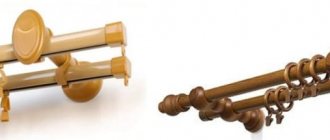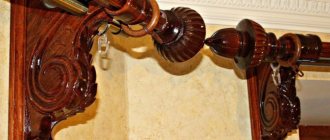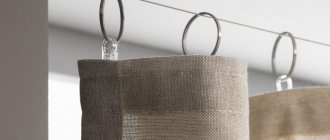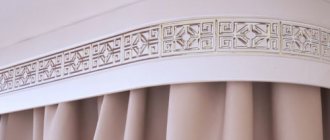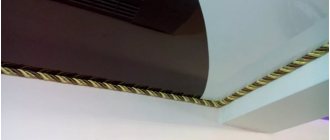The easiest and most convenient way to mount a universal-type ceiling cornice for curtains to the ceiling is on vertical support stands and a transverse horizontal rod. In practice, the last thing you have to think about is how to more conveniently hang a cornice on the ceiling; most often you have to choose a cornice structure for hanging curtains, while simultaneously focusing on the design style of the window opening and the interior of the room.
Modern plastic cornice
Design and dimensions of ceiling cornices
Traditionally, curtain retention systems have always been installed on the wall above the window opening. Only relatively recently, with the advent of large plastic windows, ceiling structures began to be used as more convenient and technologically advanced. For those who like the idea of attaching a ceiling cornice for curtains to the ceiling, several successful schemes with baguettes have been invented:
- A universal rack-mount cornice on holders or vertical transverse posts, the length of such a structure can reach 4 m, it can only be installed if intermediate supports are used;
- Wide ceiling cornice made of plastic or aluminum profile. The dimensions of this type of structure are not limited in any way; if you correctly follow the ceiling mounting technology, it is quite possible to assemble several ceiling slats combined into one system of curtains and tulle.
- Broken cornices, two-row and three-row slatted structures with round ends.
In this case, rounded ceiling cornices provide safe, convenient and very comfortable movement of curtains into the side space of the window opening. Curtains or drapes end up hidden on the sides of the window sill, which seriously affects the durability of both the hanger itself and the fabric material of the curtains.
Ceiling three-row model, distance from the wall up to 30 cm
Width of ceiling curtain rod
One of the problems that one has to face in the process of selecting the optimal cornice structure is the size of the indentation of the supporting rod or profiled rail from the vertical surface of the window opening and window sill. For wall cornices this is indeed a difficult task. A rod, string or profiled box must ensure that the curtain fabric is removed at least 2-3 cm from the edge of the window sill.
String hanger for light curtains
If you attach the cornice box directly to the ceiling, then the amount of indentation can be made unlimitedly large. Most often, the plane of the curtains is chosen based on the capabilities of the ceiling, so that the bracket for the ceiling cornice does not run over the baseboard or ceiling molding. In some cases, the amount of indentation has to be increased artificially. For example, if you install a profile that is too wide on a PVC ceiling, you will need to use an embedded element and increase the distance from the wall to 20-25 cm.
Fastening elements for installing a ceiling cornice
To install cornice structures on the ceiling, three types of fastening are used:
- Ceiling stand-holder for rod models of cornices;
- Wall bracket for slatted ceiling cornices;
- Direct mounting through holes in the housing.
The ceiling holder for the curtain rod is usually designed to install a double rod system. A very simple and reliable design, easy to install on the ceiling even without experience. The only condition is good quality of the ceiling surface.
Rod model on vertical stands
Important! The ceiling curtain rod holder must not be installed directly onto drywall, plastic, vinyl or fabric ceiling cladding.
Corner brackets allow you to attach the ceiling cornice to the wall so that the body is almost under the ceiling without touching it. That is, a clearly wall-mounted cornice structure is used as a ceiling version, although the installation of brackets is essentially no different.
Direct mounting of the housing to the ceiling is considered the most difficult to implement. The installation problem lies in the need to accurately secure the body, without deforming the guides for hanging curtains. This not only spoils the appearance, but can also cause the runners to jam when moving the curtains. An example of how you can install a ceiling curtain rod is shown in the video:
Design Features
A ceiling curtain is a device that allows you to effectively decorate a window opening with curtains. It got its name - “ceiling” - for the method of attachment to the ceiling. Today, a huge range of various variations of this interior element is available. They vary in style, material, size, and so on.
Installation should begin with measuring the size of the required curtain rods and determining the type of curtains that are preferred.
Of particular interest are the design features of curtains. The method of installation depends on them.
For thick curtains with a fairly large mass, it is better to choose metal structures or profiles made of high-strength plastic.
Depending on the appearance of the structure, ceiling curtains are divided into:
- Profile. They are an aluminum or plastic tire with a groove for runners. Such curtains are ideal for rooms with complex geometric shapes, as well as for bay windows. The profile can bend not only at right angles, but even have a rounded shape. Today this is the most common version of curtains. If desired, it can be supplemented with self-adhesive tape for convenient fastening of lambrequins, as well as a mechanism for lifting and sliding curtains.
- Strings. This is the simplest version of the curtain; it may have one or more strings made of fishing line or wire. The kit also includes fastenings with which the strings are tensioned under the ceiling. The main drawback of the design is the inability to hang heavy curtains, since the fishing line does not hold up and sags in the middle.
- Round. A set of such curtains consists of a rod (wooden, plastic, metal) and fastenings. This model will not only withstand any weight, but will also become an effective addition to the interior design.
- Baguettes. The range of such curtains is simply amazing. They are already a work of art in themselves. The main decorative element is a special strip that covers the bar and adds zest to the interior design. This design can easily withstand multi-layer heavy curtain models.
How to assemble a ceiling cornice
The simplest, fairly popular design for the ceiling is a prefabricated product of three parts - a central plastic box with two guides for hanging curtains and side caps with turns. In addition, the kit should include self-tapping screws with plastic plugs, plugs and hangers.
The first step is to make sure that the purchased version of the curtain rod holder is suitable in length for the given room. Before this, it is enough to attach the central profile above the window and make sure that there is at least another 25 cm of free space on the sides. If the central part turns out to be too long, then you will need to carefully cut the excess with a hacksaw to the required size.
Assembling a cornice body for a ceiling turns out to be no more difficult than a children's construction set.
Initially, we install a decorative facade tape on the body. We sequentially insert the flexible plastic strip onto the guides and carefully, slowly, stretch the tape along the entire length of the body.
After which you can install the side parts; they are simply inserted into the grooves and snapped into place. In principle, the baguette is ready for installation on the ceiling.
The sidewall also needs to be put into the tape
If you plan to install a rod or rack cornice, then this design does not require preliminary assembly and preparation.
How to attach a ceiling cornice - common methods
Typically, the included instructions suggest installation using the screws and plugs included with the cornice. It is not necessary to do this; each master decides independently how and on what fasteners to install the ceiling curtain rod.
How to screw a ceiling cornice through the holes
For all structures installed directly on the ceiling, the housing must have holes for self-tapping screws. It is enough just to transfer the location of the holes with markings to the ceiling and perform the fastening as is done for any suspended structures.
Attaching the ceiling cornice to the wall using brackets
Mounting the case on wall brackets is somewhat more complicated, since, in addition to ensuring the strength of the fasteners, it is necessary to maintain the horizontal alignment of the cornice relative to the window or ceiling. In this case, they resort to a little trick.
Ceiling model with adjustable bracket shelf reach
One of the brackets is placed on a horizontal rod and fixed using a screw built into the shelf, the second is mounted in advance on the wall. The entire structure is lifted to the ceiling, connected to the installed support and the optimal location on the ceiling is found. Then all that remains is to transfer the points through the bracket to the wall.
Next is a matter of technique, the holes are drilled, the remaining bracket is hammered in and attached to the wall. The cornice is returned to the installed support, the horizontal position is checked again with a building level and fixed with screws on the supports.
How to attach a cornice to the ceiling with glue
The use of adhesive compositions could be considered the most convenient and simplest option for installing a curtain rod body on the ceiling. But, despite all the temptingness of the idea, the scheme is not popular, since the strength of fastening to the ceiling with glue is inferior to fastening with self-tapping screws.
This is largely due to the low quality of the glue and non-compliance with the technology for gluing the body to the ceiling. If you have good glue and know exactly how to use it, then you can glue it, but if you only have “Liquid Nails” or “Moment” on hand, it’s better not to risk it.
Popular glue brands
Depending on the properties of the adhesive composition, its adhesion changes, as well as the time for adjustment. Popular brands of adhesive mixtures for polyurethane:
- NMC Adefix P5 is a product from Belgium, designed for fixing polyurethane or polystyrene to a porous plane.
- Moment DecoStyle is universal – suitable for a wide range of applications, elastic and waterproof. Can be used in bathrooms.
- TITANIUM Wild – sets quickly, is resistant to moisture, and easily tolerates low temperatures. Used on concrete, wood, drywall.
- Europlast Mounting - has a paste-like consistency, fixes polyurethane well on a porous base.
- Docking Orac Decor - made on a polyurethane base, sets in 30 minutes.
- Joining DECOMASTER – forms a transparent seam, sets in half an hour.
It is better to choose compositions based on polyurethane - they fix joints well, or based on acrylic - they firmly attach products to the wall with any base.
How to hang a ceiling cornice correctly
Before you begin installing the curtain rod housing on the ceiling, you must make sure of the following:
- The body and all parts of the cornice are assembled in accordance with the instructions. The sides are seated in the grooves until they stop and click;
- The surface on the ceiling is prepared for installation.
You also need to check the availability of all the required tools, fasteners, hangers, plastic plugs and screws, in general, everything that will be needed to install a plastic housing on the ceiling with minimal effort and without wasting time searching for the necessary materials.
Tools for fixing ceiling cornice
For installation you will need a minimum set of tools and accessories:
- Hammer drill or impact drill with carbide drill bit;
- Several plastic plugs with self-tapping screws, they are usually included with the cornice, so you don’t need to look for anything;
- Painting cord, pencil, tape measure;
- Phillips screwdriver or screwdriver with appropriate bit.
Sometimes you have to use a laser level to install very complex multi-tiered curtain rods on the ceiling. If you need to install a rod curtain rod on the ceiling on homemade rack holders, then without a cord or a laser level it is almost impossible to place the mount correctly and evenly on the ceiling. How exactly to fasten and how to check the position of the rack on the ceiling, each master decides independently; in this case, you can get by with a regular marking cord.
Preparing the base for installing a ceiling cornice
Before installing the assembled cornice body, it would be correct to additionally check how well the ceiling surface corresponds to the horizon level. If the apartment or house was built in good faith, then there are no problems. But it often happens that the ceiling slabs are laid with a slope. Therefore, a simple installation on the ceiling will look crooked relative to the window.
In this case, you will need to measure the deviation of the horizon ceiling plane and make several shim washers that can be used to align the plastic body with the window opening.
Marking the places where the cornice is attached to the ceiling
Initially, you need to pull the marking cord along the conditional installation line on the ceiling, always exactly parallel to the plane of the window. Since the housing is placed directly on the ceiling, and not on the wall above the window opening, it is difficult to guess how level and parallel the structure will be relative to the window and window sill. You will have to navigate exactly by the cord.
Punching holes for plugs
Next, we simply place the assembled cornice on the ceiling and align it with the stretched guide. Using a regular pencil, we transfer the markings to the ceiling surface through the holes in the body.
How to install a ceiling cornice
For fastening, you will need to drill holes in the ceiling according to the markings. You can use a hammer drill or impact drill; the depth for the plugs should be at least 35 mm. Next, blow out the dust, remaining plaster or concrete, soak the plugs in glue and hammer them into the holes.
The best mounting option
Carefully cut off the part of the plastic protruding above the ceiling surface with a knife. If the plugs fit tightly, then you don’t have to wait for the glue to dry, but immediately lay the cornice and wrap the screws in plastic bushings. After that, all that remains is to install decorative plugs on the heads of the screws and the end roundings of the body, and lay the curtain hangers.
When going to the store, we take measurements
How to attach a cornice to a suspended ceiling
Before buying the cornice you like, take the necessary measurements: the width of the window or the wall as a whole. The distance from the side walls to the cornice may differ for each type of cornice.
If you plan to hang light curtains consisting of one or two parts that will elegantly frame the window opening, then the curtain rod can be hung above the window with protruding edges of 10-25 cm. A wall-mounted curtain rod consisting of one rod is suitable for this.
The cornice should not prevent the window from opening, so it must be positioned at least 5 cm above the opening. When installing a multi-row cornice, it is important to take into account its distance from the wall; the curtains should not touch the window handles, the battery and the protruding part of the window sill. Moreover, measurements must be taken from the row closest to the window
You can attach the cornice to the entire width of the wall with a window opening: from one side wall to the opposite, it all depends on the design of the curtain. Thus, some types of curtain rods, for example for roller blinds, are attached directly to the window frame.
